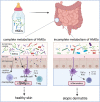Role of human milk oligosaccharide metabolizing bacteria in the development of atopic dermatitis/eczema
- PMID: 37020647
- PMCID: PMC10069630
- DOI: 10.3389/fped.2023.1090048
Role of human milk oligosaccharide metabolizing bacteria in the development of atopic dermatitis/eczema
Abstract
Despite affecting up to 20% of infants in the United States, there is no cure for atopic dermatitis (AD), also known as eczema. Atopy usually manifests during the first six months of an infant's life and is one predictor of later allergic health problems. A diet of human milk may offer protection against developing atopic dermatitis. One milk component, human milk oligosaccharides (HMOs), plays an important role as a prebiotic in establishing the infant gut microbiome and has immunomodulatory effects on the infant immune system. The purpose of this review is to summarize the available information about bacterial members of the intestinal microbiota capable of metabolizing HMOs, the bacterial genes or metabolic products present in the intestinal tract during early life, and the relationship of these genes and metabolic products to the development of AD/eczema in infants. We find that specific HMO metabolism gene sets and the metabolites produced by HMO metabolizing bacteria may enable the protective role of human milk against the development of atopy because of interactions with the immune system. We also identify areas for additional research to further elucidate the relationship between the human milk metabolizing bacteria and atopy. Detailed metagenomic studies of the infant gut microbiota and its associated metabolomes are essential for characterizing the potential impact of human milk-feeding on the development of atopic dermatitis.
Keywords: HMO metabolizing genes; atopic dermatitis; bifidobacterium infantis; eczema; human milk oligosaccharides (HMO); infant gut microbiome; metabolome; metagenome.
© 2023 Rahman, Sarwar, Potter, Comstock and Klepac-Ceraj.
Conflict of interest statement
The authors declare that the research was conducted in the absence of any commercial or financial relationships that could be construed as a potential conflict of interest.
Figures

References
Publication types
Grants and funding
LinkOut - more resources
Full Text Sources

